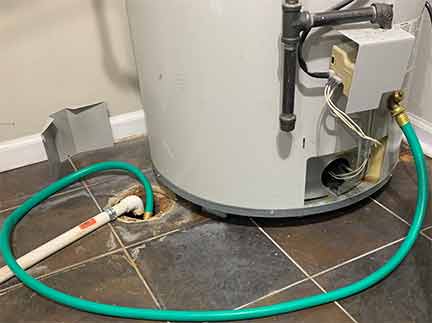
The water heater in your home is one of the most essential features of your plumbing. Every day, warm or hot water from the device is used for washing or bathing.
If the water heater fails, your home would be a less comfortable place to live in. It might even be considered uninhabitable if you’re renting it out. There are many things that can cause a water heater to malfunction.
Normally, a water heater should last 8-12 years. But this depends on how it is maintained and a vital part of maintaining the water heater is flushing and cleaning it.
Why do you need to clean a water heater, given that only clean water from the municipal water supply flows through it?
Why you should flush your water heater
Although water from the municipal supply is clean, it contains dissolved or suspended minerals. As the water flows through the plumbing in your home, some of these minerals are deposited inside the pipes.
This process is worse inside the water heater because when water is heated to evaporation point – as often happens inside the water heater tank – it leaves its dissolved content behind.
This becomes sediment that lines the sides and bottom of the water heater and interferes with its proper function. If the sediment is not removed, it can create the following problems:
- It impairs the efficiency of the water heater. Sediment forms an insulating layer between the water in the tank and the heating element. The water heater must work harder to heat water.
- There is a higher risk of corrosion, leakage, and blockages inside the water heater. Water from the water heater may also become colored.
- The possibility of the water heater exploding is high because coating on the heating element forces it to heat up to abnormal temperatures.
How to flush the water heater
Flushing your water heater every year will stir up the sediment inside the tank and flush it out. This will help you avoid water heater repair emergencies, as well as extend the life of your water heater.
How do you flush a water heater?
Flushing a water heater is not hard at all. Here is how to do it:
Turn off the heat source. For electric water heaters, find the breaker and flip it to the off position or simply unplug the water heater. But if yours is a gas water heater, change the temperature setting to pilot or vacation mode (do not turn it all the way to off or you will have to re-light the pilot light.
After disabling the heat source, locate the cold water supply valve and turn it off. You will find it on the pipe that supplies water to the heater. The valve should be lined up with the pipe, to shut it off, and turn it to a 90-degree angle.
Next, connect a garden hose to the drain spigot at the bottom of your water heater. This hose will carry the water from the water heater tank out into the yard and keep your home from being flooded.
Now you need to open the pressure relief valve on the side of the water heater to let air into the tank when you open the drain valve. If no air is going into the tank the water will not come out even if the drain valve is open.
You are all set and your water heater is ready to be drained. To release the water inside the water heater, turn the valve on the drain spigot at the bottom of the tank, where your garden hose is connected.
A word of caution, the water coming from the tank is going to be hot. Do not release it on the plants in your yard and don’t let children or pets play in it. Inspect the water to see what’s coming out of the water heater and wait until the tank is completely empty.
Note that since the flow of water from the tank was not so vigorous, you will still have sediment inside the tank. To get rid of it, open the cold water valve and let the water spray into the tank for 15-20 seconds.
Repeat this process 3-4 times or until you stop seeing any particles in the water. To make it easier to spot particulates inside the water; run some of it into a clean bucket and check.
As the last step in cleaning the tank, close the drain valve and pressure relief valve and open the cold water valve until the tank is completely filled. Now, open the drain valve and pressure relief valve and close the cold water valve until the tank is empty.
Finally, close the drain valve at the bottom, close the pressure relief valve on the side of the tank, open the cold water valve and return the heat settings for the water heater to your preferred temperature. Or simply plug the water heater back into the wall.
And that’s it; you have just flushed and cleaned your water heater. This process should be done every year. If you think the steps are too difficult to do by yourself or you notice anything strange while doing them, call a local plumber.

